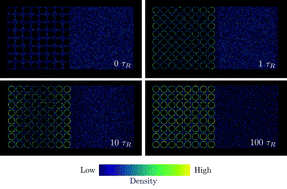Partitioning of active particles into porous media†
Abstract
Passive Brownian particles partition homogeneously between a porous medium and an adjacent fluid reservoir. In contrast, active particles accumulate near boundaries and can therefore preferentially partition into the porous medium. Understanding how active particles interact with and partition into such an environment is important for optimizing particle transport. In this work, both the initial transient and steady behavior as active swimmers partition into a porous medium from a bulk fluid reservoir are investigated. At short times, the particle number density in the porous medium exhibits an oscillatory behavior due to the particles' ballistic motion when time t < τR, where τR is the reorientation time of the active particles. At longer times, t > L2/Dswim, the particles diffuse from the reservoir into the porous medium, leading to a steady state concentration partitioning. Here, L is the characteristic length scale of the porous medium and Dswim = U0 /d(d − 1), where U0 is the intrinsic swim speed of the particles,
/d(d − 1), where U0 is the intrinsic swim speed of the particles,  = U0τR is the particles' run, or persistence, length, and d is the dimension of the reorientation process. An analytical prediction is developed for this partitioning for spherical obstacles connected to a fluid reservoir in both two and three dimensions based on the Smoluchowski equation and a macroscopic mechanical momentum balance. The analytical prediction agrees well with Brownian dynamics simulations.
= U0τR is the particles' run, or persistence, length, and d is the dimension of the reorientation process. An analytical prediction is developed for this partitioning for spherical obstacles connected to a fluid reservoir in both two and three dimensions based on the Smoluchowski equation and a macroscopic mechanical momentum balance. The analytical prediction agrees well with Brownian dynamics simulations.



 Please wait while we load your content...
Please wait while we load your content...